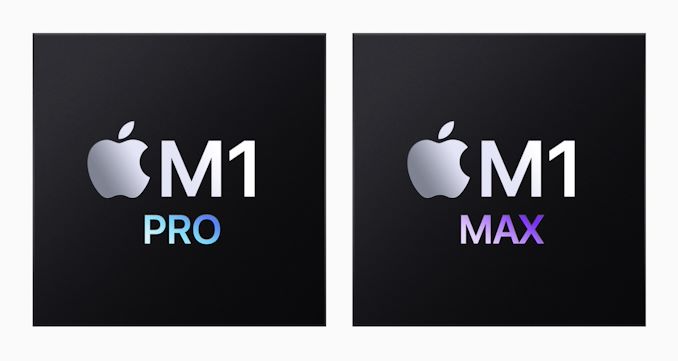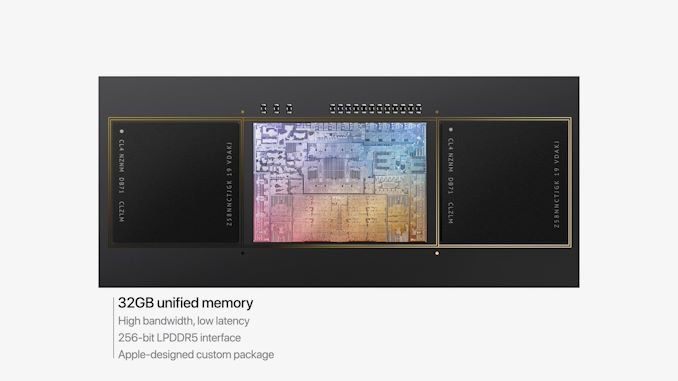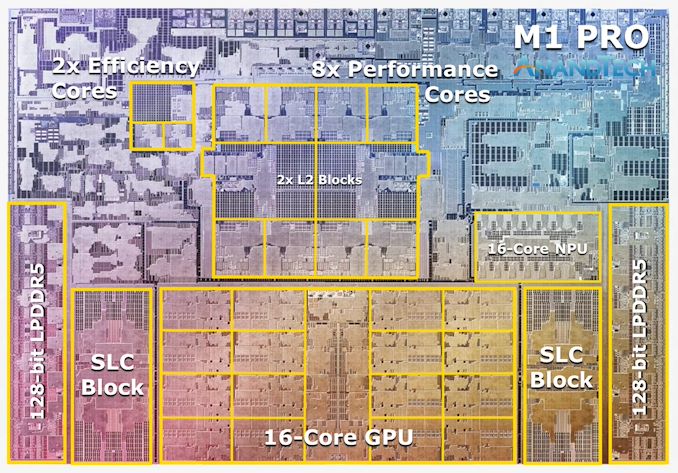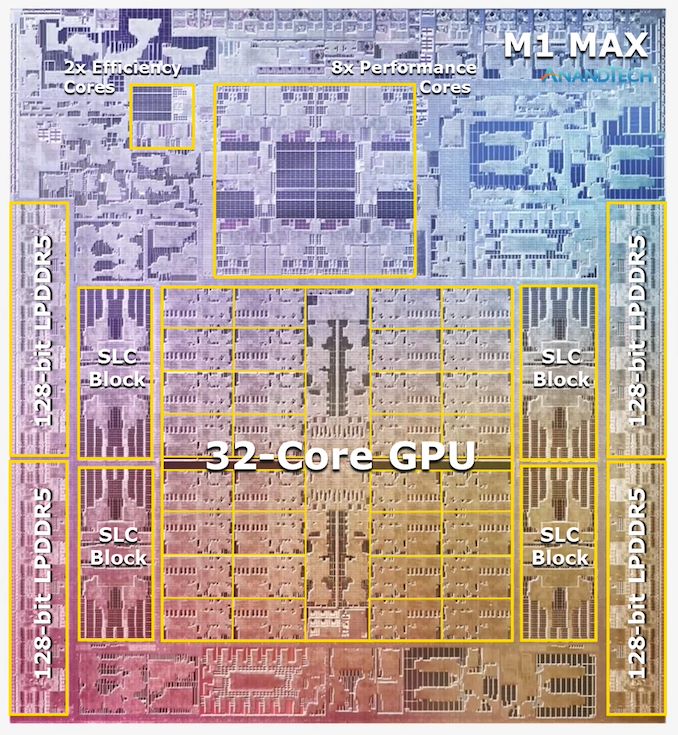Apple's M1 Pro, M1 Max SoCs Investigated: New Performance and Efficiency Heights
by Andrei Frumusanu on October 25, 2021 9:00 AM EST- Posted in
- Laptops
- Apple
- MacBook
- Apple M1 Pro
- Apple M1 Max

Last week, Apple had unveiled their new generation MacBook Pro laptop series, a new range of flagship devices that bring with them significant updates to the company’s professional and power-user oriented user-base. The new devices particularly differentiate themselves in that they’re now powered by two new additional entries in Apple’s own silicon line-up, the M1 Pro and the M1 Max. We’ve covered the initial reveal in last week’s overview article of the two new chips, and today we’re getting the first glimpses of the performance we’re expected to see off the new silicon.
The M1 Pro: 10-core CPU, 16-core GPU, 33.7bn Transistors
Starting off with the M1 Pro, the smaller sibling of the two, the design appears to be a new implementation of the first generation M1 chip, but this time designed from the ground up to scale up larger and to more performance. The M1 Pro in our view is the more interesting of the two designs, as it offers mostly everything that power users will deem generationally important in terms of upgrades.
At the heart of the SoC we find a new 10-core CPU setup, in a 8+2 configuration, with there being 8 performance Firestorm cores and 2 efficiency Icestorm cores. We had indicated in our initial coverage that it appears that Apple’s new M1 Pro and Max chips is using a similar, if not the same generation CPU IP as on the M1, rather than updating things to the newer generation cores that are being used in the A15. We seemingly can confirm this, as we’re seeing no apparent changes in the cores compared to what we’ve discovered on the M1 chips.
The CPU cores clock up to 3228MHz peak, however vary in frequency depending on how many cores are active within a cluster, clocking down to 3132 at 2, and 3036 MHz at 3 and 4 cores active. I say “per cluster”, because the 8 performance cores in the M1 Pro and M1 Max are indeed consisting of two 4-core clusters, both with their own 12MB L2 caches, and each being able to clock their CPUs independently from each other, so it’s actually possible to have four active cores in one cluster at 3036MHz and one active core in the other cluster running at 3.23GHz.
The two E-cores in the system clock at up to 2064MHz, and as opposed to the M1, there’s only two of them this time around, however, Apple still gives them their full 4MB of L2 cache, same as on the M1 and A-derivative chips.
One large feature of both chips is their much-increased memory bandwidth and interfaces – the M1 Pro features 256-bit LPDDR5 memory at 6400MT/s speeds, corresponding to 204GB/s bandwidth. This is significantly higher than the M1 at 68GB/s, and also generally higher than competitor laptop platforms which still rely on 128-bit interfaces.
We’ve been able to identify the “SLC”, or system level cache as we call it, to be falling in at 24MB for the M1 Pro, and 48MB on the M1 Max, a bit smaller than what we initially speculated, but makes sense given the SRAM die area – representing a 50% increase over the per-block SLC on the M1.
The M1 Max: A 32-Core GPU Monstrosity at 57bn Transistors
Above the M1 Pro we have Apple’s second new M1 chip, the M1 Max. The M1 Max is essentially identical to the M1 Pro in terms of architecture and in many of its functional blocks – but what sets the Max apart is that Apple has equipped it with much larger GPU and media encode/decode complexes. Overall, Apple has doubled the number of GPU cores and media blocks, giving the M1 Max virtually twice the GPU and media performance.
The GPU and memory interfaces of the chip are by far the most differentiated aspects of the chip, instead of a 16-core GPU, Apple doubles things up to a 32-core unit. On the M1 Max which we tested for today, the GPU is running at up to 1296MHz - quite fast for what we consider mobile IP, but still significantly slower than what we’ve seen from the conventional PC and console space where GPUs now can run up to around 2.5GHz.
Apple also doubles up on the memory interfaces, using a whopping 512-bit wide LPDDR5 memory subsystem – unheard of in an SoC and even rare amongst historical discrete GPU designs. This gives the chip a massive 408GB/s of bandwidth – how this bandwidth is accessible to the various IP blocks on the chip is one of the things we’ll be investigating today.
The memory controller caches are at 48MB in this chip, allowing for theoretically amplified memory bandwidth for various SoC blocks as well as reducing off-chip DRAM traffic, thus also reducing power and energy usage of the chip.
Apple’s die shot of the M1 Max was a bit weird initially in that we weren’t sure if it actually represents physical reality – especially on the bottom part of the chip we had noted that there appears to be a doubled up NPU – something Apple doesn’t officially disclose. A doubled up media engine makes sense as that’s part of the features of the chip, however until we can get a third-party die shot to confirm that this is indeed how the chip looks like, we’ll refrain from speculating further in this regard.














493 Comments
View All Comments
photovirus - Monday, October 25, 2021 - link
It ain't that easy. It took Apple a whole year just to scale the M1. And it took many more years to make M1 (namely, its Firestorm and Icestorm cores) in the first place.Also, Intel hasn't done nearly anything similar to what Apple is doing. AMD, on the other side, did the consoles which are somewhat close to what Apple offers. But still, it's not a walk in the park, and I'm quite sure both did spin some projects to make a competitor system. It might take them several years before these projects are fruitful (pun intended).
zodiacfml - Monday, October 25, 2021 - link
well they can't, only Apple has the scale and premium pricing to do this. the closest thing is AMD's SoC on the PS5/Xbox but they can't put that on a PC. AMD could make a similar SoC for PC but they certainly can't sell muchphr3dly - Monday, October 25, 2021 - link
My feeling: Apple is targeting a small market with a very small handful of SKUs. To this point their marketing seems very elegant, falling largely into the "Good, Better, Best" model that Steve Jobs introduced way back in 1998 or whenever the iMac came out.Intel meanwhile has a massive SKU database targeting hundreds (thousands?) of segments. On the one hand, that's enviable! It's a huge market, they make tons of money. On the other hand, it's not conducive to battling someone who is, at this point, tackling a very specific market.
Intel's marketing department has segmented the product line like crazy. Battling the M1 in the laptop world requires undoing a lot of that effort. Interestingly, Intel is facing the same challenge from AMD in the server space, where the Epyc SKUs are dramatically "simpler" than Xeon offerings.
I don't envy the position Intel is in, but it's their own fault for spending decades pursuing higher margins via market segmentation rather than focusing on the customer.
kwohlt - Monday, October 25, 2021 - link
Intel and AMD are working on a response for sure - but CPUs/GPUs are a slow moving business. It takes years for a new design to hit the market - there's just no way AMD or Intel could have responded in the year since the M1's release.taligentia - Monday, October 25, 2021 - link
We are still waiting on a response to the M1 and it's been out for a year now.jospoortvliet - Wednesday, October 27, 2021 - link
A fully new cpu design takes at least 3 years, so expect a response at the soonest 2 years from now and that is assuming they had a team ready to start, nothing else to do and of course were interested in countering the m1 in the first place.michael2k - Monday, October 25, 2021 - link
Generally it takes 4 years for silicon design to be completed. That means AMD, Intel, and Qualcomm would have had to look at the A11 Bionic in 2017 and think, "Self, this is an existential threat"The A11 was showcased in the iPhone 8. That wasn't exactly going to show up on anyone's radar, except maybe Qualcomm.
sirmo - Monday, October 25, 2021 - link
This SoC/APU would cost over $2000 and no one would buy it. Besides a few neck beards who just like to be different.catinthefurnace - Monday, October 25, 2021 - link
How many times do you need to be called out for making things up, and making no sense for you to stop?Drash01 - Monday, October 25, 2021 - link
End of the GPU performance section, the sentence ends abruptly: "But with the loss of Boot Camp, it’s".